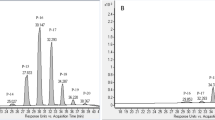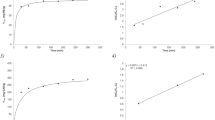Abstract
Euphausia pacific is an important source of natural astaxanthin. Studies were carried out to assess the extractability of astaxanthin from E. pacific using subcritical 1, 1, 1, 2-tetrafluoroethane (R134a). To examine the effects of multiple process variables on the extraction yield, astaxanthin was extracted under various conditions of pressure (30–150 bar), temperature (303–343 K), time (10–50 min), flow rate (2–10 g min−1), moisture content (5.5%–63.61%), and particle size (0.25–0.109 mm). The results showed that the extraction yield increased with temperature, pressure, time and flow rate, but decreased with moisture content and particle size. A maximum yield of 87.74% was obtained under conditions of 100 bar, 333 K, and 30 min with a flow rate of 6 g min−1 and a moisture content of 5.5%. The substantial astaxanthin yield obtained under low-pressure conditions demonstrates that subcritical R134a is a good alternative to CO2 for extraction of astaxanthin from E. pacific.
Similar content being viewed by others
References
Abbott, A. P., and Eardly, C. A., 1998. Solvent properties of liquid and supercritical 1, 1, 1, 2-tetrafluoroethane. The Journal of Physical Chemistry B, 102(43): 8 574–8 578.
Abbott, A. P., Eardly, C. A., and Scheirer, J. E., 1999. Solvent properties of supercritical CO2/HFC134a mixtures. The Journal of Physical Chemistry B, 103(41): 8 790–8 793.
Brunner, G., 1994. Gas Extraction: An Introduction to Fundamentals of Supercritical Fluids and the Application to Separation Processes. Springer, New York, ??-??.
Careri, M., Furlattini, L., Mangia, A., Musci, M., Anklam, E., Theobald, A., and von Holst, C., 2001. Supercritical fluid extraction for liquid chromatographic determination of carotenoids in Spirulina Pacifica algae: a chemometric approach. Journal of Chromatography A, 912(1): 61–71.
Corr, S., 2002. 1, 1, 1, 2-Tetrafluoroethane; from refrigerant and propellant to solvent. Journal of Fluorine Chemistry, 118(1–2): 55–67.
Higuera-Ciapara, I., Félix-Valenzuela, L., and Goycoolea, F. M., 2006. Astaxanthin: a review of its chemistry and applications. Critical Reviews in Food Science and Nutrition, 46(2): 185–196.
Jackson, K., and Fulton, J. L., 1996. Microemulsions in supercritical hydrochlorofluorocarbons. Langmuir, 12(22): 5 289–5 295.
Kamlet, M. J., Abboud, J. L. M., Taft, R. W., 1977. The solvatochromic comparison method. 6. The.pi.* scale of solvent polarities. Journal of the American Chemical Society, 99(18): 6 027–6 038.
Lagalante, A. F., Clarke, A. M., and Bruno, T. J., 1998. Modeling the water-R134a partition coefficients of organic solutes using a linear solvation energy relationship. Journal of Physical Chemistry B, 102(44): 8 889–8 892.
Lapkin, A. A., Plucinski, P. K., and Cutler, M., 2006. Comparative Assessment of Technologies for Extraction of Artemisinin. Journal of Natural Products, 69(11): 1653–1664.
Laurence, C., Nicolet, P., Dalati, M. T., Abboud, J. L. M., Notario, R., 1994. The Empirical Treatment of Solvent-Solute Interactions: 15 Years of.pi.*. Journal of Physical Chemistry, 98(23): 5 807–5 816.
Li, J. R., Lee, Y. M., and Yu, T., 2000. Solubilization of hydrophilic compounds in 1, 1, 1, 2-tetrafluoroethane with a cationic surfactant. Analytical Chemistry, 72(6): 1 348–1 351.
López, M., Arce, L., Garrido, J., Ríos, A., and Valcárcel, M., 2004. Selective extraction of astaxanthin from crustaceans by use of supercritical carbon dioxide. Talanta, 64(3): 726–731.
Machmudah, S., Shotipruk, A., Goto, M., Sasaki, M., and Hirose, T., 2006a. Extraction of astaxanthin from Haematococcus pluvialis using supercritical CO2 and ethanol as entrainer. Industrial and Engineering Chemistry Research, 45(10): 3 652–3 657.
Machmudah, S., Sulaswatty, A., Sasaki, M., Goto, M., and Hirose, T., 2006b. Supercritical CO2 extraction of nutmeg oil: Experiments and modeling. The Jounal of Supercritical Fluids, 39(1): 30–39.
Mira, B., Blasco, M., Berna, A., and Subirats, S., 1999. Supercritical CO2 extraction of essential oil from orange peel. Effect of operation conditions on the extract composition. The Journal of Supercritical Fluids, 14(2): 95–104.
Mustapa, A. N., Manan, Z. A., Mohd Azizi, C. Y., Nik Norulaini, N. A., and Mohd Omar, A. K., 2009. Effects of parameters on yield for subcritical R134a extraction of palm oil. Journal of Food Engineering, 95(4): 606–616.
Nagy, B., and Simándi, B., 2008. Effects of particle size distribution, moisture content, and initial oil content on the supercritical fluid extraction of paprika. The Journal of Supercritical Fluids, 46(3): 293–298.
Nobre, B., Marcelo, F., Passos, R., Beirão, L., Palavra, A., Gouveria, L., and Mendes, R., 2006. Supercritical carbon dioxide extraction of astaxanthin and othercarotenoids from the microalga Haematococcus pluvialis. European Food Research and Technology, 223(6): 787–790.
Pourmortazavi, S. M., and Hajimirsadeghi, S. S., 2007. Supercritical fluid extraction in plant essential and volatile oil analysis. Journal of Chromatography A, 1163(1): 2–24.
Qu, Y., Ni, J. R., and Huang, W., 2004. The study on extracting astaxanthin by supercritical fluid CO2. Food and Fermentation Industries, 30(12): 80–82.
Roth, M., 1996. Thermodynamic prospects of alternative refrigerants as solvents for supercritical fluid extraction. Analytical Chemistry, 68(24): 4 474–4 480.
Roy, B. C., Goto, M., and Hirose, T., 1996. Extraction of ginger oil with supercritical carbon dioxide: Experiments and modeling. Industrial and Engineering Chemistry Research, 35(2): 607–612.
Standard Operating Procedure: Assay for Vitamin A by HPLC (1992). FDA Nutrition Methodology, Food and Drug Administration, NBS SOP No. ANRS260. Rockville, MD.
Sabio, E., Lozano, M., Montero de Espinosa, V., Mendes, R. L., Pereira, A. P., Palavra, A. F., and Coelho, J. A., 2003. Lycopene and β-carotene extraction from tomato processing waste using supercritical CO2. Industrial and Engineering Chemistry Research, 42(25): 6 641–6 646.
Sachindra, N. M., Bhaskar, N., and Mahendrakar, N. S., 2006. Recovery of carotenoids from shrimp waste in organic solvents. Waste Management, 26(10): 1 092–1 098.
Sachindra, N. M., Bhaskar, N., Siddegowda, G. S., Sathisha, A. D., and Suresh, P. V., 2007. Recovery of carotenoids from ensilaged shrimp waste. Bioresource Technology, 98(8): 1 642–1 646.
Saldana, M. D. A., Zetzl, C., Mohamed, R. S., and Brunner, G., 2002. Decaffeination of Guaraná seeds in a microextraction column using water-saturated CO2. The Journal of Supercritical Fluids, 22(2): 119–127.
Selvam, P., Peguin, R. P. S., Chokshi, U., and da Rocha, S. R. P., 2006. Surfactant design for the 1, 1, 1, 2-tetrafluoroethane-water interface: ab initio calculations and in situ high-pressure tensiometry. Langmuir, 22(21): 8 675–8 683.
Shimidzu, N., Goto, M., and Miki, W., 1996. Carotenoids as singlet oxygen quenchers in marine organisms. Fisheries Science, 62(1): 134–137.
Simões, P. C., and Catchpole, O. J., 2002. Fractionation of lipids mixture by subcritical R134a in packed column. Industrial and Engineering Chemistry Research, 41(2): 267–276.
Simpson, B. K., and Haard, N. F., 1985. The use of proteolytic enzymes to extract carotenoprotein from shrimp waste. Journal of Applied Bioscience, 7: 212–222.
Stahl, E., Quirin, K. W., and Gerard, D., 1988. Dense Gases for Extraction and Refining. Springer, Berlin, Germany, 10–13.
Thana, P., Machmudah, S., Goto, M., Sasaki, M., Pavasant, P., and Shotipruk, A., 2008. Response surface methodology to supercritical carbon dioxide extraction of astaxanthin from Haematococcus pluvialis. Bioresource Technology, 99(8): 3 110–3 115.
Zhang, Y. X., Wu, L. G., Luo, Z. H., Lin, Q., and Duan, S., 2008. Extraction of astaxanthin from shrimp and its stability. Modern Food Science and Technology, 24(12): 1 288–1 291.
Author information
Authors and Affiliations
Corresponding author
Rights and permissions
About this article
Cite this article
Han, Y., Ma, Q., Wang, L. et al. Extraction of astaxanthin from Euphausia pacific using subcritical 1, 1, 1, 2-tetrafluoroethane. J. Ocean Univ. China 11, 562–568 (2012). https://doi.org/10.1007/s11802-012-1948-0
Received:
Revised:
Accepted:
Published:
Issue Date:
DOI: https://doi.org/10.1007/s11802-012-1948-0




